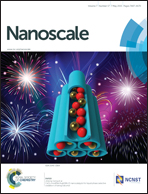Silica–gold nanoparticles for atheroprotective management of plaques: results of the NANOM-FIM trial†
Abstract
Background: Atheroregression becomes an attractive target for cardiovascular treatment. Some clinical trials have demonstrated that intensive therapy with rosuvastatin or recombinant ApoA-I Milano can partially reduce the total atheroma volume (TAV) up to 6.38 mm3 or 14.1 mm3 respectively. Our previous bench studies of selected nanotechnologies documented TAV reduction up to an unprecedented 79.4 mm3. Methods: The completed observational three arms (n = 180) first-in-man trial (the NANOM FIM trial) assessed (NCT01270139) the safety and feasibility of two delivery techniques for nanoparticles (NP), and plasmonic photothermal therapy (PPTT). Patients were assigned to receive either (1) nano-intervention with delivery of silica–gold NP in a bioengineered on-artery patch (n = 60), or (2) nano-intervention with delivery of silica–gold iron-bearing NP with targeted micro-bubbles and stem cells using a magnetic navigation system (n = 60) versus (3) stent implantation (n = 60). The primary outcome was TAV at 12 months. Results: The mean TAV reduction at 12 months in the Nano group was 60.3 mm3 (SD 39.5; min 41.9 mm3, max 94.2 mm3; p < 0.05) up to mean 37.8% (95% CI: 31.1%, 51.7%; p < 0.05) plaque burden. The analysis of the event free survival of the ongoing clinical follow-up shows the significantly lower risk of cardiovascular death in the Nano group when compared with others (91.7% vs. 81.7% and 80% respectively; p < 0.05) with no cases of the target lesion-related complications. Conclusions: PPTT using silica–gold NP associated with significant regression of coronary atherosclerosis.


 Please wait while we load your content...
Please wait while we load your content...